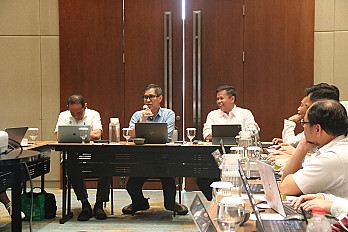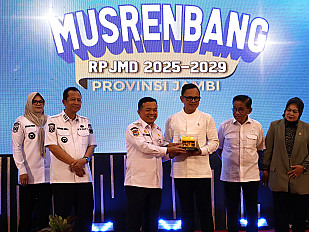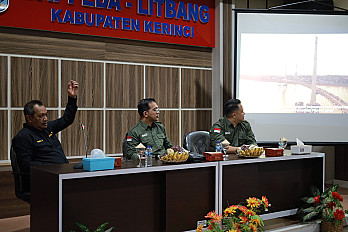News
Jambi Finalizes ESDD Documents: Concrete Climate Actions from Jambi Forest for the World

Portal BIOCF
Thursday, 12 June 2025 Post 12:06 AMTangerang, 12 June 2025 - The commitment of Jambi Province in climate action has now entered an important milestone with the completion of the Environmental and Social Due Diligence (ESDD) document for the Jambi Emission Reduction Program (JERP). This document serves as one of the main prerequisites for the Ministry of Environment, Ministry of Forestry, and the Provincial Government of Jambi to access result-based payments (Result-Based Payment/RBP) from the World Bank through the BioCarbon Fund (BioCF) scheme in the Jambi Emission Reduction Program (JERP). Furthermore, this document emphasizes that efforts to reduce carbon emissions in Jambi Province are carried out fairly, transparently, and responsibly concerning social and environmental aspects.
ESDD is not just about emission numbers—it speaks of forests, indigenous communities, small farmers, and the ecological future in Jambi that is sustainable. This document is not merely an administrative requirement. It becomes proof of the province's responsibility towards social and environmental risks, as well as an important stepping stone towards a fair green transition.Thus, the results of the discussion that finalize the draft ESDD document were held in Tangerang, June 11-12. The preparation was carried out by the Jambi local government, the national and subnational Safeguard Team, as well as independent consultants. This activity was also attended by the Director of Climate Change Mitigation of the Ministry of Environment and Forestry, accompanied by the Director of Resource Mobilization for Climate Change Control, and the Chair of the Subnational Project Management Unit (PMU) Jambi.
What is ESDD and What is its Function?
Environmental and Social Due Diligence (ESDD) is an assessment document aimed at evaluating the compatibility of emissions reduction program implementation with environmental and social protection standards. This document serves to: (1) assess compliance with the Environmental and Social Management Framework (ESMF) and the 10 World Bank safeguard standards (ESS1–ESS10), (2) measure the effectiveness of risk management in the field, (3) identify systemic gaps in program implementation, and (4) determine readiness to receive results-based payments (RBP). ESDD is an important tool to ensure accountability, transparency, and inclusiveness in the climate agenda.
Process of Preparing ESDD Documents
The preparation of the ESDD JERP document has gone through a series of technical and consultative stages, starting from the initial meeting on March 18–19, 2025, which was then reinforced in follow-up sessions on May 14–15, 2025. This process involves stakeholders from various sectors at the national, provincial, and local levels.
This due diligence is not for administrative compliance but is a form of accountability of the Indonesian Government towards the social and environmental impacts arising from the JERP. Therefore, this activity needs to carefully sift through activity data and select 14 sampling activities that represent the overall approach.
This document is prepared based on three main components of the JERP Program outlined in the Emission Reduction Program Document (ERPD), namely: strengthening institutional frameworks and governance policies for forest/land; sustainable forest and land management and strengthening low-emission value chains; and program coordination, safeguard reporting, and grievance redress systems (FGRM). Evaluation of these three components is conducted through a retrospective approach, which includes document reviews, electronic surveys, thematic discussions, and consultations with over 4,300 stakeholders across 11 districts/cities in Jambi Province.
Each component is evaluated based on five main aspects: environmental and social risk management processes, approval mechanisms, stakeholder engagement, budget allocation, and information transparency.
Safeguard Instruments, FPIC, and FGRM
ESDD is also equipped with a Feedback and Grievance Redress Mechanism (FGRM) that allows the community, especially vulnerable groups, women, and indigenous communities, to express complaints transparently and safely. This FGRM becomes an important instrument in ensuring that the principle of Free, Prior, and Informed Consent (FPIC) is implemented comprehensively.
The implementation of FPIC has been carried out in 230 villages spread across 10 districts/cities in Jambi Province during the 2022–2024 period, and it serves as an important foundation for the recognition of indigenous people's rights.
In terms of conservation, monitoring activities in areas of high conservation value (High Conservation Value/HCV) have been carried out through regular patrols and the installation of camera traps. Moving forward, these activities will be strengthened into a more effective and structured long-term monitoring system.
It is very important to see ESDD as an instrument for improvement, not just evaluation.
We cannot discuss climate success without addressing social justice. ESDD exists as a guarantor that no party will be sacrificed in the decarbonization agenda.
Strengthening REDD+ Synergy and Green Growth in Jambi
As part of the national REDD+ architecture, the implementation of the Joint Emission Reduction Program (JERP) demonstrates how a jurisdiction-based approach can have a real impact if supported by solid institutions and meaningful community involvement. This program also shows that strong safeguard mechanisms are not only important to meet donor requirements, but also serve as an essential tool to build trust between the government, indigenous communities, and development partners.
On the one hand, the Jambi Environmental Restoration Program (JERP) is also in line with the low-carbon development direction of Jambi Province, which has been outlined in the Green Growth Plan (GGP). The collaboration between local government, international partners, and local actors in the implementation of JERP strengthens the position of GGP as a sustainable development framework at the provincial level. With this synergy, Jambi is not only striving for emission targets but also ensuring that economic development and environmental protection can go hand in hand.
Editorial Note
The finalization of ESDD in Jambi Province marks not just an administrative milestone, but also substantial progress in the implementation of REDD+ safeguard principles in Indonesia. This document reflects how global climate policies can be concretely and operationally translated at the subnational level — by placing the rights of indigenous peoples, the involvement of vulnerable groups, and participatory governance as core foundations.
This success becomes a national learning model that demonstrates that carbon emission reduction programs are not just about numbers, but about ensuring social and environmental sustainability in a balanced way. With an operational grievance mechanism, strengthened legal recognition of customary rights, and the active role of local stakeholders, Jambi has now become one of the most tangible examples of how social justice can be at the heart of climate action. This is a form of green transition that is not only effective but also just.







-thumb.jpg)